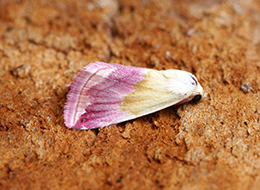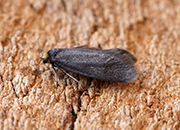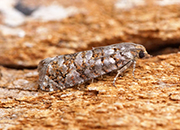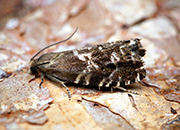In spite of poor moth trap returns for the previous week
we had a good turn out of people – perhaps it was the onion soup and other food
provided for us that attracted people! Thanks to Trevor and Chris James for this
and for generally hosting the event in a wood that is normally locked, barred
and bolted overnight. Note that Chris will be VERY pleased to hear from anyone
who wants to trap moths either regularly or occasionally in Northaw Great Wood
so the effects of management can be monitored. Please e-mail me if interested
and I will put you in touch with her.
The site has a chequered history and was
originally heathland that became wooded. It is a SSSI for its current woodland
type, which was assumed to be ancient; this designation was, it is now generally
agreed, made in error. During the past 6 years, Chris and others have cleared
tens of acres of Rhododendron and were surprised and delighted when, a year ago,
Heather suddenly re-appeared from the seed bank. Why surprised? It has been under the Rhododendron for a
hundred years – that’s why! So there is great hope for a recovery of heathy
woodland here. We ran a sheet in the cleared area, which is now dominated by
Bracken under well-spaced mature birches – I have suggested that both be partly
cleared to give the heath a better chance of recovering.
We also ran 3 Robinson traps and a fourth ran for part of
the evening at the visitor centre, turning on at about 20.15 hours. The moths
were utterly abysmal, as predicted but, non-the-less, several newcomers to our
gatherings were suitably impressed and we did get a couple of good micros, as
follows:
The grass moth Agriphila latistria is the only
species that might be vaguely associated with a sandy habitat. It is easily
recognised amongst the grass moths by the white streak that runs the full length
of the forewing, including into the terminal cilia. To my shame, I failed to
realise when we caught it that it is actually NEW TO HERTFORDSHIRE, though I did keep
the specimen. I wonder if it has reappeared with the Heather, or if it came with
the wave of Jersey Tigers, Tree-lichen Beauties and others that hit us in
mid-August?
Another good micro was Metalampra italica which I assume is
consolidating its residential status centred on woods about 5 Km to the north
(see “Moths of Hertfordshire” pages 157 – 158; there is a picture in the new
micro book by Sterling and Parsons).
The full list is as follows (if I have missed any, please
let me know). Apart from the several Light Emeralds most, if not all, were
represented in single figures. The Oak Nycteoline was not dissected, though I am
happy that it is not any other species. There were a few Hornets (Vespa crabro)
as expected here, but these were quickly potted and did not cause any problems.
We gave up in a fit of depression at about 23.15 hours.
Colin Plant (Herts Moth County Recorder)

 Musotima nitidalis
Musotima nitidalis L-album Wainscot
L-album Wainscot Feathered Ranunculus
Feathered Ranunculus Agonopterix nervosa
Agonopterix nervosa Blossom Underwing
Blossom Underwing Beautiful Marbled
Beautiful Marbled Lampronia fuscatella
Lampronia fuscatella Gravitarmata margarotana
Gravitarmata margarotana Perittia obscurepunctella
Perittia obscurepunctella Black-spotted Chestnut
Black-spotted Chestnut Cydia pactolana
Cydia pactolana











.JPG)




































